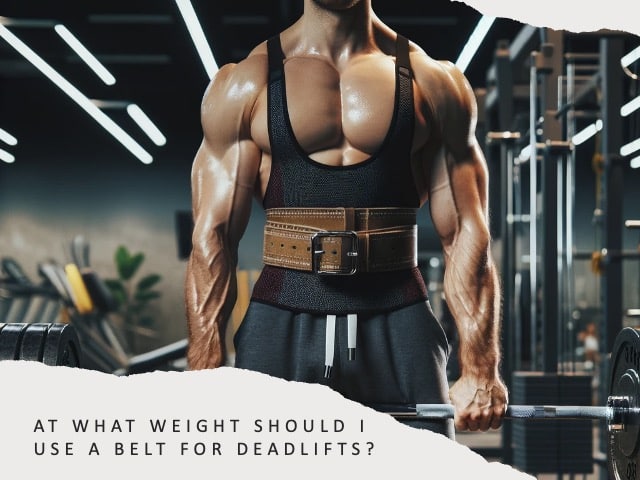At What Weight Should I Use a Belt for Deadlifts?
Deadlifts are a fundamental part of most weightlifters’ training routines.
They’re excellent at engaging several muscle groups in your body, building core strength, and strengthening your glutes and lower back.
Nonetheless, as lifters progress, many people wonder: at what weight should I start wearing a waist belt?
Well, it’s a matter of personal preference and depends on an individual’s technique, priorities, lifting experience, and such.
Understanding the Purpose of Weightlifting Belts
Before we get into the ins and outs of wearing a belt while deadlifting, let’s first understand what these belts are meant to do for you.
Essentially, their purpose is to be used as a supporting tool that provides a safety net to your vulnerable lower back, enhancing safety, stability, and performance while lifting heavy.
By no means should be used as a crutch to get away with bad lifting technique or improper training.
Factors to Consider
If you’re on the fence about whether or not you should use a weightlifting belt for your deadlifts, taking the following factors into account may help you make an informed decision.
1. Lifting Experience
As a beginner, your goal should be to learn the basics of deadlift form and technique, allowing your body to build strength and core stability.
Using a belt at this stage may not be necessary since you’re looking to master the correct form instead of just relying on ‘training wheels.’
On the other hand, if you’re an experienced individual trying to apply progressive overload with heavier weights, having a belt around your waist can make the whole ordeal much safer.
It reduces spinal curvature and has major protective effects, which brings us to the next point.
2. Weight Being Lifted
With lighter weight, the spine and your core muscles aren’t in as much danger of sustaining an injury.
With heavier loads, however, a lot more power and stability are required of your core and spinal cord.
As a general rule of thumb, the heavier you lift, the more beneficial it may be for you to use a weightlifting belt.
Bear in mind that the concept of “lifting heavy” is subjective.
What’s heavy for one lifter may be light work for another.
So, it’s important to consider your individual strength and experience level when deciding whether or not you want to use a weightlifting belt.
As a general rule of thumb, lifters may find that using a belt becomes more beneficial as they approach higher percentages of their one-repetition maximum (1RM).
3. Injury History
Individuals with a history of back injuries or lower back pain may find that a weightlifting belt provides added support and confidence during deadlifts.
But, make sure you address any underlying issues and consult with a healthcare professional before relying solely on a belt to mitigate discomfort.
4. Technique and Form
Proper technique and form should always be the primary focus when performing deadlifts.
A weightlifting belt should never be used as a substitute for proper lifting mechanics.
If a lifter cannot maintain a neutral spine, engage the core muscles, and perform the movement safely, they may not be ready to incorporate a belt into their routine.
When to Use a Weightlifting Belt
While there is no definitive answer to the question of when to use a weightlifting belt for deadlifts, several scenarios warrant consideration:
1. Near Maximal Effort Lifts
During sets approaching or exceeding 85-90% of your 1RM, a weightlifting belt can provide added stability and confidence, allowing you to lift heavier loads safely.
2. Personal Preference
Ultimately, the decision to use a weightlifting belt for deadlifts comes down to personal preference.
Some lifters may find that they perform better and feel more secure with a belt, while others may prefer to lift without one.
Experimenting with different approaches and listening to your body can help you determine what works best for you.
3. Comfort
If you’re new to using weightlifting belts, you may find it slightly uncomfortable to deadlift with them.
However, minor inconveniences in your comfort level can be fixed by finding the right belt instead of ditching it altogether.
For instance, you can find additional padding or softer materials in some weightlifting belts, especially in female models.
4. Competition Preparation
If you compete in powerlifting or weightlifting competitions where the use of a weightlifting belt is permitted, it’s essential to train with one to acclimate to its feel and maximize performance on the platform.
5. Back Support
Individuals who experience discomfort or instability in their lower back during deadlifts may benefit from using a weightlifting belt as a supportive measure.
However, it’s crucial to address any underlying issues and prioritize proper form and technique.
Final Thoughts – Should You Use a Weightlifting Belt?
While belts can provide added support and stability, they should not be viewed as a substitute for proper training and technique development.
However, strategic implementation can play a role in facilitating muscular development and total body strength.
Consulting with a qualified coach or trainer can provide valuable guidance on when and how to use a weightlifting belt effectively.



